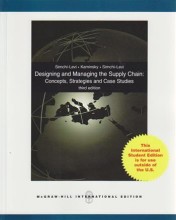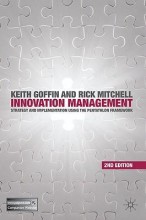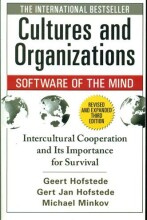Summary: Designing And Managing The Supply Chain | 9780071270977 | David Simchi Levi
- This + 400k other summaries
- A unique study and practice tool
- Never study anything twice again
- Get the grades you hope for
- 100% sure, 100% understanding
Read the summary and the most important questions on Designing and Managing the Supply Chain | 9780071270977 | David Simchi-Levi.
-
1 Introduction
This is a preview. There are 1 more flashcards available for chapter 1
Show more cards here -
1.1 What is supply chain management?
This is a preview. There are 1 more flashcards available for chapter 1.1
Show more cards here -
Why is Supply Chain Management difficult?
1. Supply chain strategies cannot be determine in isolation. They are directly affected by another chain that most organizations have.
2. It is challenging to design and operate a supply chain so that total systemwide costs are minimized and systemwide service levels are maintained.
3. Uncertainty and risk are inherent in every supply chain -
1.3 Global optimization
-
What factors make finding the best systemwide, or globally optimal, integrated solution so difficult and a challenging problem?
1. The supply chain is a complex network of facilities dispersed over a large geography, and, in many cases, all over the globe.
2. Different facilities in the supply chain frequently have different, conflicting objectives.
3. The supply chain is a dynamic system that evolves over time.
4. System variations over time are also an important consideration. -
1.4 Managing uncertainty and risk
-
Global optimization is made even more difficult because supply chains need to be designed for, and operated in, uncertain environments, thus creating sometimes enormous risks to the organization. Which factors contribute to this?
1. Matching supply and demand is a major challenge.
2. Inventory and back-order levels fluctuate considerably across the supply chain, even when customer demand for specific products does not vary greatly.
3. Forecasting doesn't solve the problem.
4. Demand is not the only source of uncertainty. Delivery lead times, manufacturing yields, transportation times and component availability also can have significant supply chain impact.
5. Recent trends such as lean manufacturing, outsourcing, and offshoring that focus on cost reduction increase risks significantly. -
1.5 The evolution of supply chain management
This is a preview. There are 1 more flashcards available for chapter 1.5
Show more cards here -
What happened during the 80s?
Companies discovered new manufacturing technologies and strategies that allowed them to reduce costs and better compete in difficult markets. -
What happened during the 90s?
Many companies focused on strategies to reduce their costs as well as those of their supply chain partners. At the same time, many supply chain partners engage in information sharing so that manufacturers are able to use retailers' up-to-date sales data to better predict demand and reduce lead times.
Another huge pressure to reduce costs and increase profits pushed many industrial manufacturers towards outsourcing.
Finally, in the late 90s, the Internet and the related e-business models led to expectations that many supply chain problems would be solved merely by using these new technologies and business models. -
Name a number of approaches that have been applied by industry to manage risk in their supply chains.
- Building redundancy into the supply chain so that if one portion fails, the supply chain can still satisfy demand
- Using information to better sense and respond to disruptive events
- Incorporating flexibility into supply contracts to better match supply and demand
- Improving supply chain processes by including risk assessment measures
-
1.6 The complexity
-
Name the three critical abilities that successful firms must posses.
1. The ability to match supply chain strategies with product characteristics.
2. The ability to replace traditional supply chain strategies, in which each facility or party in the chain makes decisions with little regard to their impact on other supply chain partners, by those that yield a globally optimized supply chain.
3. The ability to effectively manage uncertainty and risk. -
1.7 Key issues in supply chain management
-
On which levels can supply chain issues be found?
1. Strategic level = deals with decisions that have a long-lasting effect on the firm.
2. The tactical level = includes decisions that are typically updated anywhere between once every quarter and once every year.
3. The operational level = refers to day-to-day decisions such as scheduling, lead time quotations, routing and truck loading. -
Name some possible issue areas concerning supply chain management.
- Distribution Network Configuration
- Inventory Control
- Production Sourcing
- Supply Contracts
- Distribution Strategies
- Supply Chain Integration and Strategic Partnering
- Outsourcing and Offshoring Strategies
- Product Design
- Information Technology and Decision-Support Systems
- Customer Value
- Smart Pricing
- Distribution Network Configuration
-
2 Inventory Management and Risk Pooling
-
2.1 Introduction
This is a preview. There are 9 more flashcards available for chapter 2.1
Show more cards here -
What is the goal of effective inventory management in the supply chain?
The goal is to have the correct inventory at the right place at the right time to minimize system costs while satisfying customer service requirements.
- Higher grades + faster learning
- Never study anything twice
- 100% sure, 100% understanding
Topics related to Summary: Designing And Managing The Supply Chain
-
Inventory Management and Risk Pooling - Introduction
-
Inventory Management and Risk Pooling - Single stage inventory
-
Inventory Management and Risk Pooling - Risk pooling
-
Inventory Management and Risk Pooling - Centralized versus decentralized systems
-
Inventory Management and Risk Pooling - Managing inventory in the supply chain
-
Inventory Management and Risk Pooling - Forecasting
-
Network Planning - Network design - Data aggregation
-
Network Planning - Network design - Transportation rates
-
Network Planning - Network design - Solution techniques
-
Network Planning - Network design - Key features of a network configuration SCP
-
Network Planning - Inventory positioning and logistics coordination - Strategic safety stock
-
Network Planning - Inventory positioning and logistics coordination - Integrating inventory positioning and network design
-
Network Planning - Resource allocation
-
Strategic components - Supply contracts
-
Supply Contracts - Contracts for make-to-stock/make-to-order supply chains
-
Supply Contracts - Contracts for nonstrategic components
-
De waarde van informatie - The Bullwhip effect
-
De waarde van informatie - Information sharing and incentives
-
De waarde van informatie - Effective forecasts
-
De waarde van informatie - Information for the coordination of systems
-
De waarde van informatie - Information and supply chain trade-offs
-
Supply Chain Integration - Push, pull and push-pull systems - Pull-based supply chain
-
Supply Chain Integration - Push, pull and push-pull systems - Push-pull supply chain
-
Supply Chain Integration - Push, pull and push-pull systems - Implementing a push-pull strategy
-
Supply Chain Integration - The impact of lead time
-
Supply Chain Integration - Demand-driven strategies
-
Supply Chain Integration - The impact of the internet on supply chain strategies
-
Distribution Strategies - Direct shipment distribution strategies
-
Distribution Strategies - Intermediate inventory storage point strategies
-
Strategic Alliances - Third-party logistics - What is 3PL?

































